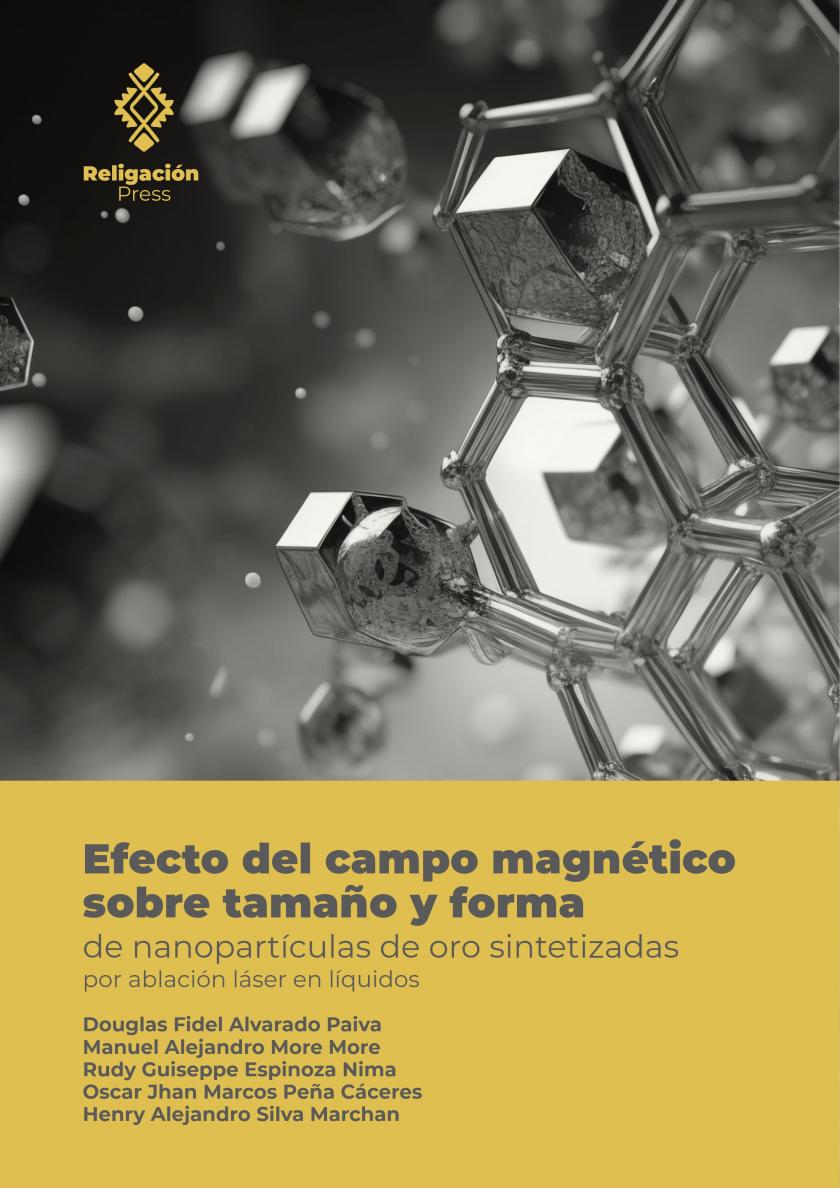Efecto del campo magnético sobre tamaño y forma de nanopartículas de oro sintetizadas por ablación láser en líquidos
Palabras clave:
Ablación láser; nanopartículas de oro; campo magnético.Sinopsis
El objetivo del estudio fue examinar el impacto de la aplicación de un campo magnético externo en las características de nanopartículas de oro, las cuales fueron sintetizadas mediante ablación láser pulsada en agua bidestilada, utilizando longitudes de onda de irradiación láser de 532 nm y 1064 nm. El campo magnético fue aplicado de dos maneras: durante todo el proceso de síntesis por ablación láser pulsada y posteriormente al coloide con nanopartículas después de la síntesis. Los resultados indican que es factible controlar el tamaño de las nanopartículas esféricas de oro mediante la aplicación del campo magnético tanto durante como después del proceso de síntesis. Además, se observó la capacidad de obtener nuevas formas, como ovoides y barras. Por último, se destaca que el efecto principal del campo magnético durante la síntesis es el aumento de la concentración de nanopartículas de oro obtenidas mediante el método de ablación láser en medios líquidos.
Descargas
Citas
Alvarado Paiva, D. (2020). Efecto del campo magnético sobre tamaño y forma de nanoparticulas de oro y plata sintetizadas por ablacion laser en liquidos [Tesis de doctorado, Universidad Nacional de Trujillo].
Alvarado, D., Aldama-Reyna, C., & Agreda-Delgado, J. (2020). Tratamiento Magnético de Nanoparticulas de Oro Sintetizadas por Ablación Laser. Revista Ciencia y Tecnología, 16(1), 191-197. https://revistas.unitru.edu.pe/index.php/PGM/article/view/2767
Agreda, J. (2017). Estudio fotoacústico de la estabilidad de nanopartículas de plata obtenidas por ablación láser en función del tiempo [Tesis de Maestría, Universidad Nacional de Trujillo].
Alba, J. (2013). Estudio de la Ablación Láser mediante la Fotoacústica Pulsada: Síntesis de Nanopartículas [Tesis de Maestría, Universidad de Guanajuato]. https://acortar.link/v2dxY7
Al-Dahash, G., Obaid, N.M., & Majeed, H.A. The effect of liquid environment and magnetic field on optical properties of Pt nanoparticles colloidal prepared by pulsed laser ablation. International Journal of ChemTech Research, 9(10), 118-130. https://sphinxsai.com/2016/ch_vol9_no10/1/(118-130)V9N10CT.pdf
Al-hddad, R., Jumaa, T., & Hamid, M.K. (2014). The effect of applied external magnetic field on the synthesis of nanogold particles via laser ablation. Unique Journal of Engineering and Advanced Sciences, 65-73.
Amendola, V., & Meneghetti, M. (2009). Laser ablation synthesis in solution and size manipulation of noble metal nanoparticles. Physical chemistry chemical physics 11(20), 3805-3821.
Amendola, V., & Meneghetti, M. (2013). What controls the composition and the structure of nanomaterials generated by laser ablation in liquid solution? Physical Chemistry Chemical Physics, 15(9), 3027-3046.
Barcikowski, S., Amendola, V., Marzun, G., Rehbock, C., Reichenberger, S., Zhang, D., & Gökce, B. (2016). Handbook of laser synthesis of colloids. Duisburg-Essen Publications online. http://dx.doi.org/10.17185/duepublico/41087
Barcikowski, S.A., Menéndez-Manjón, B., Chichkov, M., Brikas & Račiukaitis, G. (2007). Generation of nanoparticle colloids by picosecond and femtosecond laser ablations in liquid flow. Applied Physics Letters, 91(8), 083113.
Baruah, P.K., Singh, A., Rangan, L., Sharma, A.K., & Khare, A. (2020). Elucidation of size, structure, surface plasmon resonance, and photoluminescence of Ag nanoparticles synthesized by pulsed laser ablation in distilled water and its viability as SERS substrate. Applied Physics A, 126(3), 1-14.
Chen, J., Li, X., Gu, Y., Wang, H., Song, X., & Zeng, H. (2017). Probing mesoscopic process of laser ablation in liquid by integrated method of optical beam deflection and time-resolved shadowgraphy. Journal of colloid and interface science, 489, 38-46.
De Anda Villa, M., Gaudin, J., Amans, D., Boudjada, F., Bozek, J., Evaristo Grisenti, R., & Papagiannouli, I. (2019). Assessing the Surface Oxidation State of Free-Standing Gold Nanoparticles Produced by Laser Ablation. Langmuir, 35(36), 11859-11871.
De Giacomo, A., Dell’Aglio, M., Santagata, A., Gaudiuso, R. De Pascale, O., Wagener, P., Messina, G. Compagnini, G., Barcikowski, S. (2013). Cavitation dynamics of laser ablation of bulk and wire-shaped metals in water during nanoparticles production. Physical Chemistry Chemical Physics 15(9), 3083-3092.
De la Venta, G. (2009). Propiedades magnéticas de nanopartículas de oro [Tesis Doctoral, Universidad Complutense de Madrid]. Repositorio Institucional. https://hdl.handle.net/20.500.14352/48815
Dorranian, D.S., Tajmir, S., & Khazanehfar, F. (2013). Effect of laser fluence on the characteristics of Ag nanoparticles produced by laser ablation. Soft Nanoscience Letters, 3(04), 93-100. http://dx.doi.org/10.4236/snl.2013.34017
Elsayed, K.A., Imam, H., Ahmed, M.A., & Ramadan, R. (2013). Effect of focusing conditions and laser parameters on the fabrication of gold nanoparticles via laser ablation in liquid. Optics & Laser Technology, 45, 495-502.
Hu, L., Zhang, R., & Chen, Q. (2014). Synthesis and assembly of nanomaterials under magnetic fields. Nanoscale, 6(23), 14064-14105.
Imam, H., Elsayed, K., Ahmed, M.A., & Ramdan, R. (2012). Effect of experimental parameters on the fabrication of gold nanoparticles via laser ablation. Optics and Photonics Journal, 2(2) .http://dx.doi.org/10.4236/opj.2012.22011
Ismail, R. A., Sulaiman, G. M., & Abdulrahman, S.A. (2016). Preparation of iron oxide nanoparticles by laser ablation in DMF under effect of external magnetic field. International Journal of Modern Physics B, 30(17), 1650094. https://doi.org/10.1142/S0217979216500946
Khilkhal, W., Al-Dahash, G.,& Ne’ma, S. (2014). Preparation of gold NPs colloidal by laser ablation under the effects of magnetic field. Aust. J. Basic Appl. Sci, 8(18), 159-162.
Kim, K.K., Roy, M., Kwon, H., Song, J.K., & Park, S.M. (2015). Laser ablation dynamics in liquid phase: The effects of magnetic field and electrolyte. Journal of Applied Physics, 117(7), 074302.
López-Téllez, G., Morales-Luckie, R., Olea-Mejía, O., Sánchez-Mendieta, V., Trujillo-Reyes, J., Varela-Guerrero, V., & Vilchis-Néstor, A. (2013). Nanoestructuras Metálicas: Síntesis. Caracterización Y Aplicaciones, DF.
Mafuné, F., Kohno, J.-y., Takeda, Y., Kondow, T., & Sawabe, H. (2000). Formation and size control of silver nanoparticles by laser ablation in aqueous solution. The Journal of Physical Chemistry B, 104(39), 9111-9117.
Muto, H., Yamada, K., Miyajima, K., & Mafuné, F. (2007). Estimation of surface oxide on surfactant-free gold nanoparticles laser-ablated in water. The Journal of Physical Chemistry C, 111(46), 17221-17226.
Musaev, O., Sutter, E., Wrobel, J., & Kruger, M. (2016). The effect of magnetic fields on the products of laser ablation. Applied Physics A, 122(95). https://doi.org/10.1007/s00339-016-9636-3
Nealon, G.L., Donnio, B., Greget, R., Kappler, J.-P., Terazzi, E., & Gallani, J.-L. (2012). Magnetism in gold nanoparticles. Nanoscale, 4(17), 5244-5258.
Niu, K.-Y., Park, J., Zheng H., & Alivisatos, A.P. (2013). Revealing bismuth oxide hollow nanoparticle formation by the Kirkendall effect. Nano letters, 13(11), 5715-5719.
Niu, K.-Y., Yang, J., Sun, J., & Du, X.-W. (2010). One-step synthesis of MgO hollow nanospheres with blue emission. Nanotechnology, 21(29), 295604.
Niu, K., Yang, J., Kulinich, S., Sun, J., Li, H., & Du, X. (2010). Morphology control of nanostructures via surface reaction of metal nanodroplets. Journal of the American Chemical Society, 132(28), 9814-9819.
Sakka, T., Iwanaga, S., Ogata, Y.H., Matsunawa, A., & Takemoto, T. (2000). Laser ablation at solid–liquid interfaces: An approach from optical emission spectra. The Journal of Chemical Physics, 112(19), 8645-8653.
Saxena, I., Wolff, S., & Cao, J. (2015). Unidirectional magnetic field assisted laser induced plasma micro-machining. Manufacturing Letters, 3, 1-4.
Serkov, A., Rakov, I., Simakin, A., Kuzmin, P., Mikhailova, G., Antonova, L.K., Troitskii, A., Kuzmin, G., & Shafeev, G. (2016). Influence of external magnetic field on laser breakdown plasma in aqueous Au nanoparticles colloidal solutions. arXiv preprint arXiv, 1602, 08335.
Shih, C.-Y., Wu, C., Shugaev, M.V., & Zhigilei, L.V. (2017). Atomistic modeling of nanoparticle generation in short pulse laser ablation of thin metal films in water. Journal of colloid and interface science, 489, 3-17.
Sylvestre, J.P., Poulin, S., Kabashin, A.V., Sacher, E., Meunier, M., & Luong, J.H. (2004). Surface chemistry of gold nanoparticles produced by laser ablation in aqueous media. The Journal of Physical Chemistry B, 108(43), 16864-16869.
Solati, E., & Dorranian, D. (2015). Comparison between silver and gold nanoparticles prepared by pulsed laser ablation in distilled water. Journal of Cluster Science, 26(3), 727-742.
Song, S.-T., Cui, L., Yang, J., & Du, X.-W. (2015). Millisecond laser ablation of molybdenum target in reactive gas toward MoS2 fullerene-like nanoparticles with thermally stable photoresponse. ACS applied materials & interfaces, 7(3), 1949-1954.
Talukder, A., Sultana, P., Haider, A., Wahadoszamen, M., Abedin, K.M., & Farhad, S. (2010). Power dependence of size of laser ablated colloidal silver nanoparticles. The European Physical Journal D, 60(2), 295-300.
Tan, D., Sharafudeen, K.N., Yue, Y., & Qiu, J. (2016). Femtosecond laser induced phenomena in transparent solid materials: Fundamentals and applications. Progress in Materials Science, 76, 154-228.
Tiberi, M., Simonelli, A., Cristoforetti, G., Marsili, P., Giammanco, F., & Giorgetti, E. (2013). Effect of picosecond laser induced cavitation bubbles generated on Au targets in a nanoparticle production set-up. Applied Physics A, 110(4), 857-861.
Tsuji, T., Iryo, K., Watanabe, N., & Tsuji, M. (2002). Preparation of silver nanoparticles by laser ablation in solution: influence of laser wavelength on particle size. Applied Surface Science, 202(1-2), 80-85.
Tsuji, T., Nakanishi, M., Mizuki, T., Ozono, S., Tsuji, M., & Tsuboi, Y. (2012). Preparation and Shape-Modification of Silver Colloids by Laser Ablation in Liquids: A Brief Review. Science of Advanced Materials, 4(3-4), 391-400.
Wang, W., Dahl, M., & Yin, Y. (2012). Hollow nanocrystals through the nanoscale Kirkendall effect. Chemistry of Materials, 25(8), 1179-1189.
Xiao, J., Liu, P., Wang, C., & Yang, G. (2017). External field-assisted laser ablation in liquid: An efficient strategy for nanocrystal synthesis and nanostructure assembly. Progress in Materials Science, 87, 140-220.
Yang, G. (2007). Laser ablation in liquids: Applications in the synthesis of nanocrystals. Progress in Materials Science, 52(4), 648-698.







